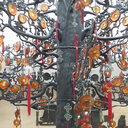Dickeya zeae strains isolated from rice, banana and clivia rot plants show great virulence differentials.
Lykilorð
Útdráttur
BACKGROUND
Dickeya zeae is the causal agent of maize and rice foot rot diseases, but recently it was also found to infect banana and cause severe losses in China. Strains from different sources showed significant diversity in nature, implying complicated evolution history and pathogenic mechanisms.
RESULTS
D. zeae strains were isolated from soft rot banana plants and ornamental monocotyledonous Clivia miniata. Compared with D. zeae strain EC1 isolated from rice, clivia isolates did not show any antimicrobial activity, produced less extracellular enzymes, had a much narrow host ranges, but released higher amount of extracellular polysaccharides (EPS). In contrast, the banana isolates in general produced more extracellular enzymes and EPS than strain EC1. Furthermore, we provided evidence that the banana D. zeae isolate MS2 produces a new antibiotic/phytotoxin(s), which differs from the zeamine toxins produced by rice pathogen D. zeae strain EC1 genetically and in its antimicrobial potency.
CONCLUSIONS
The findings from this study expanded the natural host range of D. zeae and highlighted the genetic and phenotypic divergence of D. zeae strains. Conclusions can be drawn from a series of tests that at least two types of D. zeae strains could cause the soft rot disease of banana, with one producing antimicrobial compound while the other producing none, and the D. zeae clivia strains could only infect monocot hosts. D. zeae strains isolated from different sources have diverse virulence characteristics.




